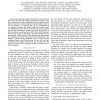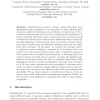145 search results - page 28 / 29 » The use of random simulation in formal verification |
INFOCOM
2012
IEEE
11 years 10 months ago
2012
IEEE
—By exploiting reception diversity of wireless network links, researchers have shown that opportunistic routing can improve network performance significantly over traditional ro...
INFOCOM
2010
IEEE
13 years 6 months ago
2010
IEEE
Abstract—We provide a formal model for the Change Management process for Enterprise IT systems, and develop change scheduling algorithms that seek to attain the “change capacit...
TLDI
2009
ACM
14 years 4 months ago
2009
ACM
The importance of distributed systems is growing as computing devices become ubiquitous and bandwidth becomes plentiful. Concurrency and distribution pose algorithmic and implemen...
SUTC
2008
IEEE
14 years 2 months ago
2008
IEEE
A piece of Hovering Information is a geo-localized information residing in a highly dynamic environment such as a mobile ad hoc network. This information is attached to a geograph...
RECOMB
2004
Springer
14 years 8 months ago
2004
Springer
Identifying gene clusters, genomic regions that share local similarities in gene organization, is a prerequisite for many different types of genomic analyses, including operon pred...


